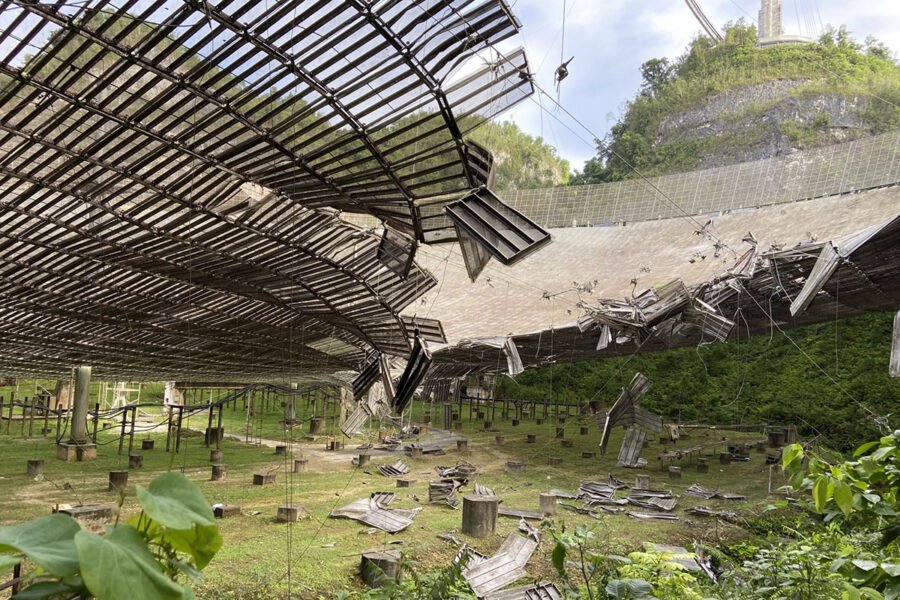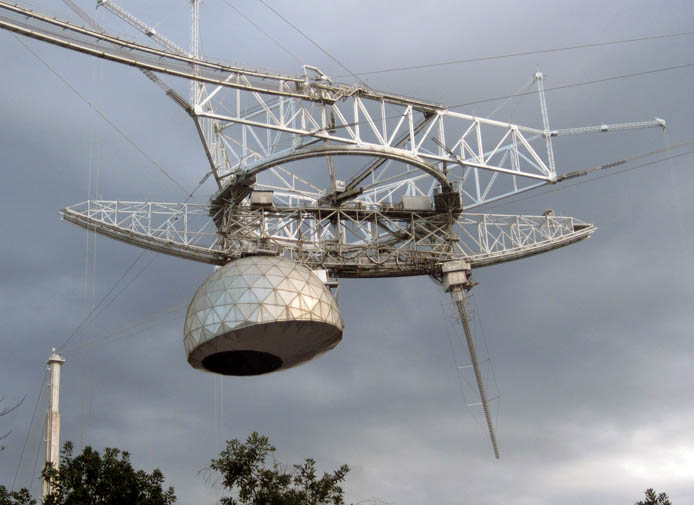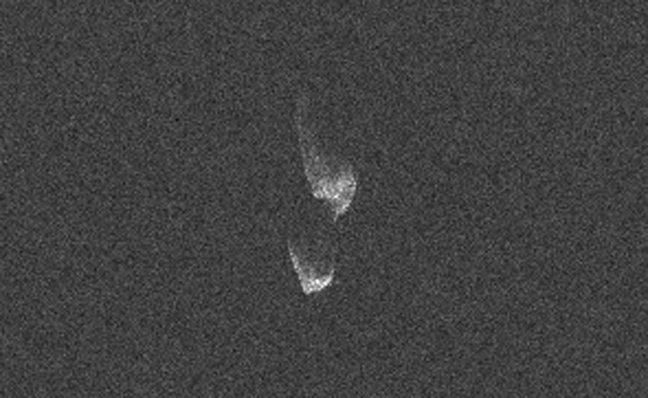
UCF / NSF
Arecibo Observatory, the iconic 305-meter (1,000-foot) radio dish nestled in the forested hills in Puerto Rico, is to be decommissioned for safety reasons, say officials with the National Science Foundation (NSF).
The announcement follows two unexpected and devastating events. In August, a cable that helped support the receiver platform suspended over the dish wrenched out of its socket, twisting the 900-ton platform and crashing down on the dish below. Engineers assessed the damage, but before orders for replacements had a chance to come through, another cable snapped on November 6th, causing additional damage and leaving the structural integrity of the telescope unclear. Attempts to repair the telescope could put lives at risk.
“Any engineering approach to better understanding the strength left in the main cables involves considerable risk for human life and could in fact accelerate the uncontrolled collapse of the structure,” says Ralph Gaume, director of NSF’s Division of Astronomical Sciences.
The loss of the 57-year-old observatory comes as a shock to the astronomy community. Arecibo’s huge collecting area, incredible sensitivity, and radar capabilities enables it to study everything from near-Earth asteroids to distant galaxies; scientists also use the dish for investigations of Earth’s atmosphere.
“I’m devastated,” says Alessondra Springman (University of Arizona). “There’s nothing else like this in the world, there’s nothing that can do what Arecibo does.”
What Went Wrong
Multiple cables suspend a 900-ton platform 450 feet above Arecibo’s dish. Twelve 3.25-inch-thick cables were added in the 1990s to support additional weight added to this platform as part of a major upgrade to the observatory. On November 6th, one of those 12 auxiliary cables tore out of its socket and fell to the ground.

UCF / NSF
Arecibo’s structure is designed to be redundant, so when the auxiliary cable failed, load transferred to the four original cables and the remaining support cable. Engineers were called in immediately to assess the damage and, on determining the structure was stable, to begin repairs. Supplies were on order for temporary cables to help carry the load, as well as two replacement cables for both the cable that had failed and the other auxiliary cable for that tower.
But before those replacements could arrive, one of the main cables to the same tower snapped on November 6th. This unexpected break caused engineers to doubt the entire structure’s integrity. The engineering companies reported individual wires breaking on other main cables, as well as additional slippage of other auxiliary cables in their sockets. If another cable breaks, “a catastrophic failure would be likely,” writes John Abruzzo, from the engineering consulting firm Thornton Tomasetti. “We believe the structure will collapse in the near future if left untouched.”

Sky & Telescope / J. Kelly Beatty
Despite inspections following the August event, nobody had any inkling that the main cable would break — it should have been able to bear much more weight than it did. It could be that the older design of the main cable, which could have let moisture in even with regular maintenance, led it to snap, says Arecibo program director Ashley Zauderer.
The support cable failure is a different story: “The auxiliary cable, installed in the 1990s, was much younger and should not have failed the way it did,” Zauderer says. “It slipped right out of the socket. The team is looking very closely at why that happened. It should not have happened.”
What Happens Now
The engineering firms are recommending that Arecibo be decommissioned in a controlled way, but what that looks like remains to be seen. The engineering firms will take 5 or 6 weeks to develop a plan, Gaume says, but until then both the cost and the timeline of the decommissioning are up in the air.
“Our engineers are not able to tell us when the structure would collapse on its own,” Gaume adds. “So we’re working against the clock to develop plans for a controlled decommissioning with the priorities being safety, and the safety and preservation of the rest of the assets of the observatory.”

Planetary Radar Science Group / NSF
Gaume and Zauderer both emphasize that the decommissioning does not mean the end of the observatory. Even as they take down the main dish and suspended dome, they will preserve important buildings under Tower 12. The observatory’s LIDAR facilities, which use lasers to investigate Earth’s atmosphere, will also continue.
“We’re talking about a structure made of steel and cables, but it truly is the people who had the ideas,” Zauderer says. Dedicated staff has helped the observatory survive earthquakes and hurricanes, and the observatory functioned as a staging area for aid following Hurricane Maria.
“Pretty much every schoolchild on the island has been to Arecibo. Everyone has had family who worked there, who helped build it,” Springman explains. “You can’t have an observatory without the people, and the people also derive great benefit from the observatory being there.”
Arecibo is also irreplaceable for scientists. Even though it’s technically the second-largest radio dish in the world (China’s Five-hundred-meter Aperture Spherical Telescope, or FAST, recently broke the record Arecibo held for decades), the observatory has unique capabilities, among them its radar. “FAST cannot do radar, it’s specifically incapable of doing active observation,” Springman explains. Because of that, FAST can’t take Arecibo’s place in planetary defense by characterizing asteroids and their orbits.
Over the past decade, Arecibo has survived earthquakes, hurricanes, and funding struggles. “They try to kill it every few years, and someone pulls a rabbit out of a hat,” Springman says. But what the observatory’s future holds isn’t clear. “I’m not sure what’s going to happen to it now.”